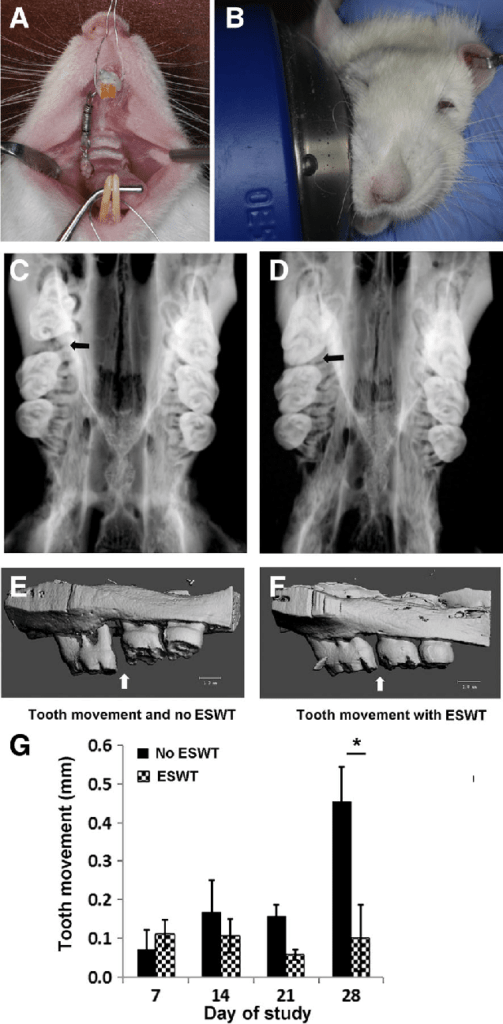Orthodontics, a dynamic field continuously evolving, incorporates new technologies and methodologies to optimize treatment outcomes. One intriguing area of research is combining orthodontic force with extracorporeal shock wave therapy (ESWT). This innovative approach, which is at the forefront of orthodontic advancements, enhances tooth movement and influences bone morphometry. This blog post delves into this cutting-edge approach’s scientific principles, mechanisms, and potential benefits.
Orthodontic Force: The Foundation of Tooth Movement
Orthodontic treatment relies on applying controlled mechanical forces to teeth, guiding them into more desirable positions. This process involves:
- Bone Remodeling: Orthodontic force induces a biological response in the periodontal ligament (PDL) and alveolar bone. Osteoclasts resorb bone on the pressure side, while osteoblasts form new bone on the tension side.
- Cellular and Molecular Changes: The mechanical force triggers a cascade of cellular and molecular events, including the release of cytokines and growth factors, which mediate bone remodeling.
- Tooth Movement Phases: Tooth movement occurs in three phases—initial, lag, and post-lag—each characterized by distinct cellular activities and tissue responses.
Extracorporeal Shock Wave Therapy (ESWT): A Novel Adjunct
ESWT involves the application of high-energy shock waves to a targeted area, which is traditionally used in orthopedics for conditions like tendinitis and bone fractures. Its integration into orthodontics is based on its potential to:
- Enhance Bone Remodeling: ESWT can stimulate osteogenesis and angiogenesis, promoting faster and more efficient bone remodeling.
- Modulate Inflammatory Response: By influencing cytokine production, ESWT can modulate the inflammatory response, potentially reducing discomfort and accelerating tissue repair.
- Improve Cellular Activity: Shock waves can enhance the proliferation and differentiation of osteoblasts and osteoclasts, key players in bone remodeling.

Combining Orthodontic Force with ESWT: Mechanistic Insights
The synergy between orthodontic force and ESWT is hypothesized to optimize tooth movement through several mechanisms:
- Accelerated Bone Turnover: The combined mechanical and shock wave stimuli may synergistically enhance bone turnover, leading to more rapid orthodontic tooth movement (OTM).
- Improved Bone Quality: ESWT’s osteogenic effects can improve bone density and quality around moving teeth, potentially reducing treatment time and relapse risk.
- Enhanced Cellular Response: The dual stimulation may amplify the cellular and molecular responses necessary for efficient bone remodeling and tooth movement.
Assessing Orthodontic Tooth Movement and Bone Morphometry
To evaluate the efficacy of this combined approach, researchers employ various assessment methods:
- Radiographic Analysis: Techniques like CBCT (cone-beam computed tomography) provide detailed images of tooth positions and bone structures, allowing precise measurement of tooth movement and bone changes.
- Histological Studies: Examining tissue samples under the microscope reveals cellular and tissue-level changes, offering insights into the biological processes underlying OTM and bone remodeling.
- Biomechanical Assessments: Evaluating the mechanical properties of bone and periodontal ligament helps understand how combined forces impact the structural integrity and function of the orthodontic apparatus.
Clinical Implications and Future Directions
The integration of ESWT into orthodontic practice holds promising potential:
- Reduced Treatment Time: By accelerating tooth movement, ESWT could significantly shorten the duration of orthodontic treatments.
- Enhanced Patient Comfort: Modulating the inflammatory response may reduce pain and discomfort associated with orthodontic force application.
- Improved Outcomes: Enhanced bone quality and stability around moved teeth could lead to better long-term results and reduced relapse rates.
Conclusion
The combination of orthodontic force with extracorporeal shock wave therapy represents a cutting-edge advancement in orthodontics, with the potential to revolutionize how we approach tooth movement and bone morphometry. As research in this area progresses, we may witness a new era of more efficient, comfortable, and effective orthodontic treatments.
References
- Krishnan, V., & Davidovitch, Z. (2006). Cellular, molecular, and tissue-level reactions to orthodontic force. American Journal of Orthodontics and Dentofacial Orthopedics, 129(4), 469.e1-469.e32.
- Wang, C. J. (2012). Extracorporeal shockwave therapy in musculoskeletal disorders. Journal of Orthopaedic Surgery and Research, 7(1), 11.
- Duda, G. N., & Hutmacher, D. W. (2010). Influence of mechanical conditions on tissue engineering of vascularized bone. Biomaterials, 31(21), 5147-5156.
- Hagai Hazan-Molina el al. (2022). Orthodontic force and ESWT: Assessment of orthodontic tooth movement and bone morphometry in a rat model. Archives of Oral BiologyVolume 134

